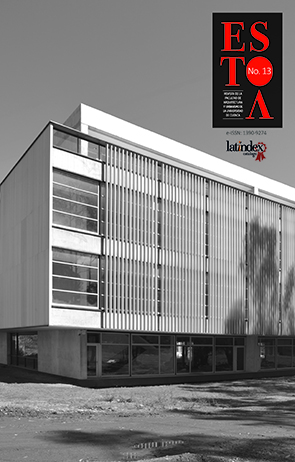Digital photogrammetry for the 3D model of the archeological site of Todos Santos, Cuenca (Ecuador)
DOI:
https://doi.org/10.18537/est.v007.n013.a02Keywords:
Photogrammetry, 3D Survey, Cultural Heritage, Archeology, Cuenca, Todos SantosAbstract
Advances in technology have changed the perspective of the human being on the world; in recent years there has been a rapid increase in technological advances in various fields, conservation and management of cultural heritage have not remained indifferent, three-dimensional digital photogrammetry has broken in its favor, especially in the field of documentation, with possibilities of being used for multiple purposes, involving patrimonial assets such as the case of the archaeological site of Todos Santos in Cuenca (Ecuador), characterized by evidence of three cultures: Cañari, Inca and Española. In this site, a photogrammetric survey was carried out framed in a formative experience that included the process of construction of the 3D model, from the taking of images, to the work in different softwares and the final renderings. The possibilities of this process are versatile, however, complementary as a technical input of knowledge and dissemination to traditional documentation techniques; for cases where its potential contributes to the integral conversation and is adjusted to the availability of existing resources.
Downloads
References
Antoñanzas, M. A., Iguácel de la Cruz, P., Lopetegui Galarraga, A., & Valle Melón, J. M. (2003). El Sequeral (Calahorra, La Rioja). Investigación fotogramétrica y arqueología. Arqueología de La Arquitectura, (2), 13–16. doi.org/10.3989/arqarqt.2003.i2
Aparicio Resco, P., Carmona Barrero, J. D., Fernández Díaz, M., & Martín Serrano, P. M. (2014). Fotogrametría Involuntaria: rescatando información geométrica en 3D de fotografías de archivo. Virtual Archaeology Review, 5(10), 11–20.
Barber, L. (2013). (Re) Making Heritage Policy in Hong Kong: A Relational Politics of Global Knowledge and Local Innovation. Urban Studies, 51 (6), 1179–1195. doi.org/10.1177/0042098013495576
Charquero Ballester, A. M., & López Lillo, J. A. (2012). Registro tridimensional acumulativo de la secuencia estratigráfica: fotogrametría y SIG en la intervención arqueológica de lo Boligni (Alacant). Virtual Archaeology Review, 3, 81–88. Recuperado de http://193.145.233.67/dspace/handle/10045/33415
Criado-Boado, F., & Barreiro, D. (2013). El patrimonio era otra cosa. Estudios Atacameños, (45), 5–18.
De Reu, J., Plets, G., Verhoeven, G., De Smed, P., Machteld, B., Cherretté, B. De Clercq, W. (2013). Towards a three-dimensional cost-effective registration of the archaeological heritage. Journal of Archaeological Science, 40 (2), 1108–1121.
ICOMOS. (2004). Carta ICOMOS para la Interpretación y Presentación de Sitios de Patrimonio Cultural. Ratificada por la 16 Asamblea General del ICOMOS, Québec (Canadá). Recuperado de https://www.icomos.org/images/DOCUMENTS/Charters/interpretation_sp.pdf
IERSE. (2016). Fotogrametría arquitectural. Recuperado de http://gis.uazuay.edu.ec/ide2015/fortalecimiento_infraestructura.php
Lerma, J. L., Navarro, S., Cabrelles, M., & Villaverde, V. (2010). Terrestrial laser scanning and close range photogrammetry for 3D archaeological documentation: the Upper Palaeolithic Cave of Parpalló as a case study. Journal of Archaeological Science, 37(3), 499–507. Recuperado de http://www.sciencedirect.com/science/article/pii/S0305440309003781
Monfort-Roselló, M. (2012). Multimedio para la Difusión del Patrimonio Natural y Cultural. San Juan: Editorial Académica Española.
Querol, M. Á. (2010). Manual de gestión del patrimonio cultural (1era Edición). Madrid. Ediciones Akal S. A.
Rinaudo, F., Chiabrando, F., Lingua, A., & Spanò, A. (2012). Archaelogical site monitoring: UAV photogrametry can be a answer. International Archives of the Photogrammetry, Remote Sensing and Spatial Information Sciences, XXXIX (B5), 583–588.
Santos, P., Ritz, M., Fuhrmann, C., Monroy, R., Schmedt, H., Tausch, R. Fellner, D. (2017). Acceleration of 3D Mass Digitization Processes: Recent Advances and Challenges. In M. Ioannides, N. Magnenat-Thalmann & G. Papagiannakis (Eds.), Mixed Reality and Gamification for Cultural Heritage. Springer Cham 99–128). doi.org/10.1007/978-3-319-49607-8_4
Yilmaz, H. M., Yakar, M., Gulec, S. A., & Dulgerler, O. N. (2007). Importance of digital close-range photogrammetry in documentation of cultural heritage. Journal of Cultural Heritage, 8(4), 428–433. doi.org/10.1016/j.culher.2007.07.004
Published
How to Cite
Issue
Section
License
The Journal declines any responsibility for possible conflicts derived from the authorship of the works that are published in it.
The University of Cuenca in Ecuador conserves the patrimonial rights (copyright) of the published works and will favor the reuse of the same ones, these can be: copy, use, diffuse, transmit and expose publicly.
Unless otherwise indicated, all contents of the electronic edition are distributed under a Creative Commons Attribution-NonCommercial-ShareAlike 4.0 International License.




